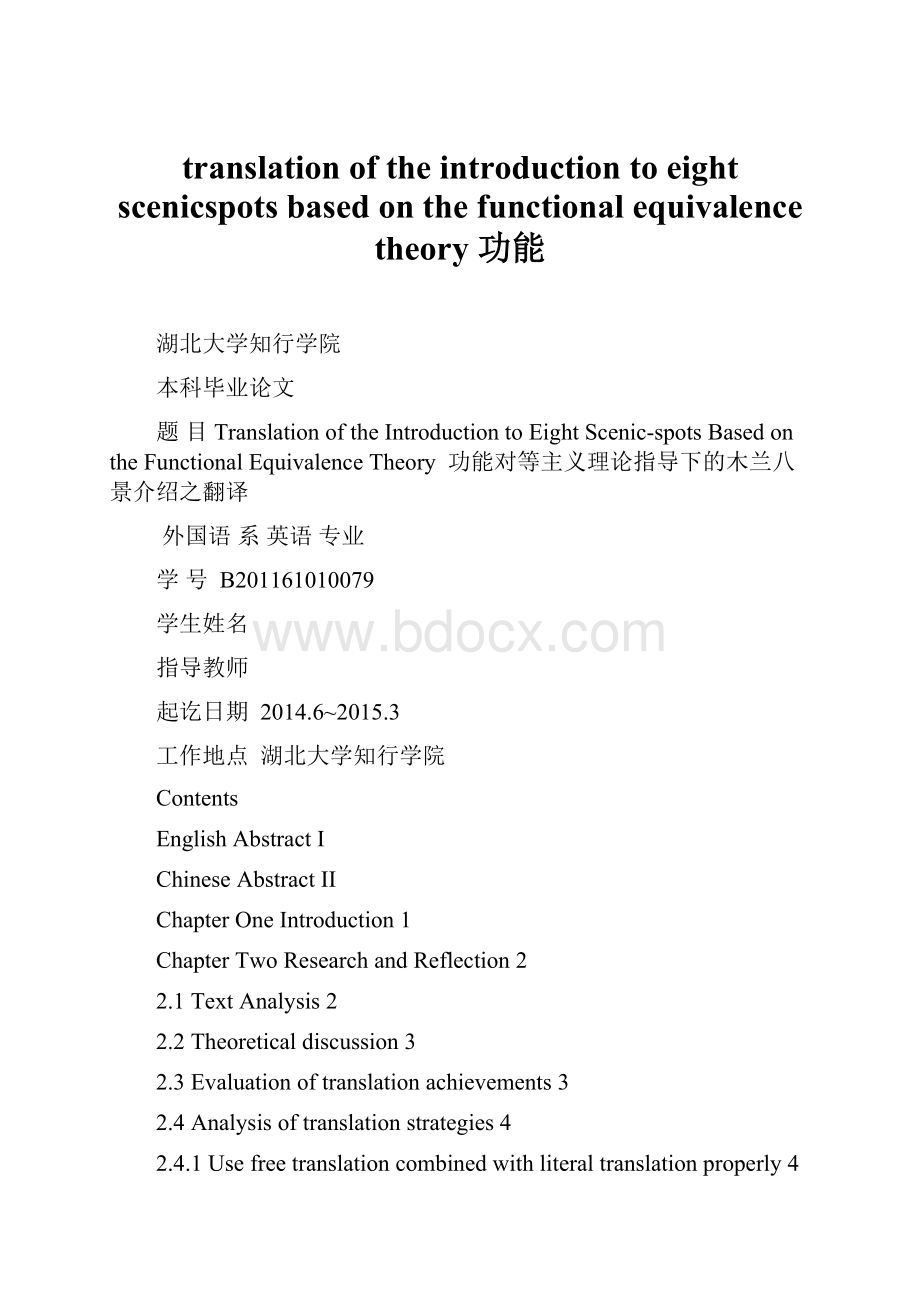translation of the introduction to eight scenicspots based on the functional equivalence theory 功能.docx
《translation of the introduction to eight scenicspots based on the functional equivalence theory 功能.docx》由会员分享,可在线阅读,更多相关《translation of the introduction to eight scenicspots based on the functional equivalence theory 功能.docx(32页珍藏版)》请在冰豆网上搜索。

translationoftheintroductiontoeightscenicspotsbasedonthefunctionalequivalencetheory功能
湖北大学知行学院
本科毕业论文
题目TranslationoftheIntroductiontoEightScenic-spotsBasedontheFunctionalEquivalenceTheory功能对等主义理论指导下的木兰八景介绍之翻译
外国语系英语专业
学号B201161010079
学生姓名
指导教师
起讫日期2014.6~2015.3
工作地点湖北大学知行学院
Contents
EnglishAbstractI
ChineseAbstractII
ChapterOneIntroduction1
ChapterTwoResearchandReflection2
2.1TextAnalysis2
2.2Theoreticaldiscussion3
2.3Evaluationoftranslationachievements3
2.4Analysisoftranslationstrategies4
2.4.1Usefreetranslationcombinedwithliteraltranslationproperly4
2.4.2Functionalequivalence6
2.4.3Annotation7
2.4.4Amplification7
2.5Reflectiononpractice8
ChapterThreeConclusion9
Bibliography11
Acknowledgement12
Appendix11
Appendix21
目录
英文摘要I
中文摘要II
第一章绪论1
第二章研究及反思2
2.1文本分析2
2.2理论介绍3
2.3成果概述3
2.4技巧使用分析4
2.4.1直译与意译结合4
2.4.2功能主义翻译理论6
2.4.3运用加注法7
2.4.4运用加词法7
2.5实践反思8
第三章总结9
参考文献11
致谢12
附录11
附录21
Abstract
Tourism,isactuallyakindofculturalactivitycenteredaroundthescenicspots.Englishisworldacknowledgedlanguagewhichhasthemostoverwhelmingcrowds.Manycountries’commonpeoplehavelearnedEnglish.Andintheircountries,therearemanyforeignworldfriends.Soonthewalkoftourism,whenmanytranslatorstranslateandintroducethescenicspotstotheforeigntourists,90%ofthetranslatorsutilizeEnglishlanguage.
Asweallknow,thequalityoftourismtranslationiscloselyboundupwiththetourismdevelopmentinthescenicspots.However,thefactwefacedleavesusmuchtobedesired.Therefore,asatranslator,hestillneedstoomuchtolearn.Notonlyisthetranslatorsupposedtohavethefavorableandexquisitemasteroftranslations,butalsothetranslatorshouldbeencyclopedic.Inaddition,heshouldevenmorebearmedwiththeunweariedspirittoactivelyseekforandexplorethedifferentandsamepointsbetweenthetwocultures.Soinaculturalperspective,theauthorcanbemoreeasiertoanalyzeandtranslate,toelevatetheappreciationgivenbytheforeignfriends,tobettercommunicatewitheachothertopromotetheculturaltransmissionandexchange,toacceleratethetourismdevelopment,tostrengthenthepowerofGDP.Nevertheless,inWuhan,therearealotoffamousalonespotsthathaven’tbeensystematicallytranslated,forexamplethesocalledMulanEightScenic-spots.
Inthispaper,theauthorbrieflytranslatedtheintroductiontotheeightspots.Infact,todefinethetranslationisactuallydifficult,Nida,thewellrecognizedleadingfigureinthefieldsoftranslatingin20thcentury,oncedefinedthetranslationasfollows:
Translationistheclosestandmostnaturalequivalentlanguageofprimitiveinformationfromsemanticstostyleinreproducinginthereceptorlanguage.Heputforwardthefunctionalequivalencetranslationnamelythedynamicequivalencetranslation,whichbroughttheworldmuchandinvaluablebenefits.Histheoryhasbrokenupthetraditionalmethodofpartialtranslationstandardsandtraditionalcriterion.Ithasahugeandgreatimpactonthetraditionaltranslationstrategies.Itdestroyedthedeadlockoftraditionaltranslation,thrivingandflourishingleft.
TheauthormainlyusethetheoryofNidaanddeeplyhopesthatthistranslationcanprovidesomehelptothedevelopmentofthosespots,canevoketheinterestofothertranslators,canserveasamodestspurtobringthemtocomeforwardwiththeirinvaluablecontribution.
[KeyWords]tourismtranslation;propagandamaterial;interculturalcommunication
摘要
旅游,从本质上来讲是一种围绕着景点展开的文化活动。
英语被世界上公认为世界使用的第一大语言。
多数国家都有学过英语,在许多国家有很多的国际友人。
那么在旅游方面,对于国际友人,对旅游景点介绍作翻译基本上90%都使用的是英语。
那么我们可以看得出来景点翻译的质量好坏是与旅游区旅游事业的发展息息相关,但是摆在面前的事实并不是那么乐观的。
那么作为译者,需要做的需要学习的还有很多很多。
不仅要求译者要具有良好的精湛的翻译功底,还要有广博的文化知识,更要有积极探索发现两种文化之间的异同点的孜孜不倦的精神。
从而从文化等个角度去准确地分析把握和得出翻译成果,提升国际友人对我国英语学习者的欣赏态度、更好地沟通中西方以促进文化的传播与交流、促进旅游业的兴旺发展、增强国内生产总值的动力。
然而在武汉,还有一些著名景点被孤置,至今无人作出系统翻译,例如译者在此所提的木兰八景。
在这篇论文中,译者在此对木兰八景的介绍作了简要的翻译,其实要定义翻译其实是很难的,奈达,国际公认的20世纪翻译界的泰斗人物,曾经给翻译下过这样一个定义,翻译是从语义到文体在译语中用最贴切而又最自然的对等语再现原语的信息。
他提出的功能翻译对等即动态对等给世界的翻译学者带来了前所未有的利益,他的理论打破了传统的片面的翻译标准翻译方法,对传统翻译进行了一次巨大的冲击与革命,打破了传统片面翻译的僵局,使得翻译界欣欣向荣、蔚然成风。
此文之中,作者主要运用和阐释了尤金奈达的翻译理论,希望此拙作能在木兰八景的旅游事业上提供一些微助,能够引起各译者对木兰八景翻译的兴趣,希望能在此抛砖引玉,尽献绵薄之力。
那么译者首先对景点翻译的背景作了简要介绍,对翻译现状进行了概述,随后对文本及译本进行了分析,对翻译技巧的使用作了说明,最后以实践反思及总结作了最终叙述。
[关键词]旅游翻译;宣传资料;跨文化交际
ChapterOneIntroduction
Translationisapieceofwritingorspeechthathasbeenputintoadifferentlanguage.Itistheinterpretingofthemeaningofatextandthesubsequentproductionofanequivalenttextthatcommunicatesthesamemessageinanotherlanguage.Thecommunicationsnarrowalltheworld;thelanguageenrichthewholeworld;thetranslationsconnectthegreatworld.Translatingisabridge,abond,asignificantpartincultureactivities.Onlyiftherewashumancommunication,therewouldexisttranslatingactivities.
Astimegoesby,theexternalexchangeexpandsandthetourismdevelops.Ithasbeenmoreclusteredforeignfriendstoourcountrysincethereformandopening-uppolicytookeffect.Therefore,thetranslatorstakemoretranslatingopportunitiesandassignments.Becausetheculturalbackground,theviewofvalue,thewayofthinking,thelanguagestylisticfeaturearedifferent.WhenintroducingthespotstotheChinesevisitors,wemostlyutilizedescribingandgorgeouslanguagetocometothebeautyinsound,instructure,inmeaning.Butwhenitcomestotheforeignvisitors,inthecourseofthetranslating,theauthormustconsiderthesourcetext,thegrammarrulesofthetwolanguages,thewritingconventionsandalsotheidioms.Accuracyinatranslationisamajorfactorthatdeterminesgoodqualityofthetranslation,withnoexceptiontothetourismtranslation.
Inourworld,currentlytherearemanytranslatingstrategiesandtheories,suchasLiteraltranslationandFreetranslation,domesticationandforeignization,annotation,amplification,Omission,conversion,negation,Dynamicequivalence(alsoknownasthefunctionalequivalence),semantictranslationandcommunicativetranslationbyNewmark.
Whentranslating,theauthorwillusuallyutilizetheproperskillsandstrategiesintranslation.BecausethedistinguishedfeaturesinChineseandEnglish,thewordsChineseandEnglishcan’tbecorrespondingonebyone.Butnomatterwhattheskillsheused,themeaningitderivescan’tbealtered.Andtheauthorusesthosemuchtranslatingtheoryinthepaper.Itaimstomakethelanguagetransformationclearandfluency.Inthisgraduationpaper,theauthortranslatedtheintroductiontotheMulanEightScenic-spots.Intheprocessofthetranslating,theauthorhasgotmuchinnerthoughtsandlearnedtoutilizemuchtranslatingstrategies.
ChapterTwoResearchandReflection
TranslationoftheIntroductiontoEightScenic-spotsisgenerallyakindofpracticalversiontranslation.Broadlyspeaking,thetourismtranslationismainlyaimedatsupplyingmorerelativenatureandhumaneknowledge.Thustheauthorcoulddigestusefulknowledgeandevokethereaderandthelistener’sinterestintourism.WhereasthethinkinghabitandculturebetweentheChineseandtheforeignpeopleareanimmeasurablyvastdifference.Therefore,tonarrowthisdifference,someskillsandstrategiesarewellcommonutilized.Inthisresearchandreflection,theauthorfirstlydescribedwhatthetextanalysisisandthenbrieflymakeananalysistothetextofappendix.Thenheintroducedsometheoriescombinedwiththeappendix.
2.1TextAnalysis
TranslationorientedtextanalysispatterncomeforwardbyChristianeNord,German.Hesaidthattextanalysiscontributestoelevatingthetranslator’sanalyticalabilitytotexts.Translationisacross-cultureactivity.Asatranslator,heshouldbeacquiredwiththeabilitytomasterthetargetlanguage,thesourcelanguageandthetranslatingtheme.Someexpertsintranslationhavefoundthreetypesofskillstotranslate.First,translateatthelevelofwords.Second,translateatthelevelofclauses.Third,Translateatthelevelofconceptormeaning.Atthefirstlevel,sourcelanguagehasitscorrespondingtargetlanguage,sothistranslatingskillisveryefficientespeciallyforhepropernounsandthephrases,suchasintheauthor’spaper,thenameofplaces,Wuhan,Huangpiandsoon.
However,becauseofthedifferenceofsyntaxbetweenChineseandEnglish,thesecondlevelofclauseisusuallywithmuchproblems.Throughthisskill,ourtranslationissometimescomplex.Thus,itishardforthereadertounderstandwhatyoumean.
Forexample,intheauthor’spapertherearesomeplainsentencesthatyoucanfindtheircorrespondingtargetlanguage.Suchas“它是一个千年宗教名胜”,sowecaneasilytranslateitintotargetlanguagelikethatitisathousand-yearreligioustourattraction.Butforsomeothersourcelanguage,wehavenoabilitytotranslateitveryclear.Wejustneedsometranslatingstrategytotranslatesuchasfreetranslation.Forexampleinthepaper“仿佛山在千山之外,水在万水之中”.ThereisanimmeasurablyvastartisticconceptionintheChineseversion.Thushere,wecouldn’ttranslateitwordbyword.Wemustuseskillstotranslateitbyfreetranslationtoreachthegoaloffunctionalequivalenceinsteadoftranslatingwordsonebyone.ItsmagnificenceisjustexpressedastheChineseversion“海阔凭鱼跃,天高任鸟飞”.Hence,wecantranslateitaswefeelagrandspectaclelikethewideseaallowsthefishtoleapaboutandthevastskythebirdstofly.Wejustsuddenlyfeelourselvessmallwhenwestandbesidetheoceananddownthesky.Thatistosayatthelevelofconceptormeaning,wetranslateitnotjustbywordsorsentencebuttheconceptorme